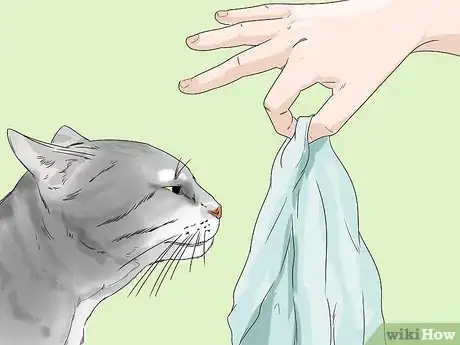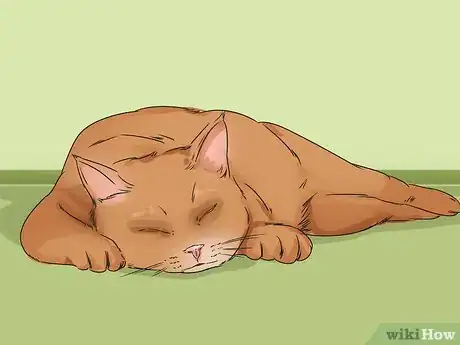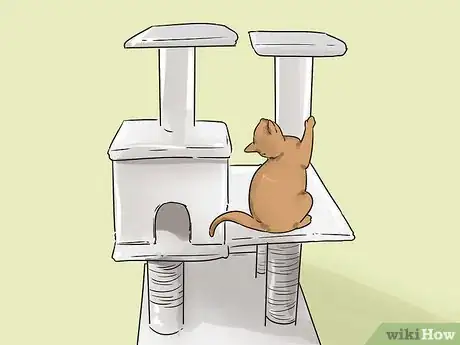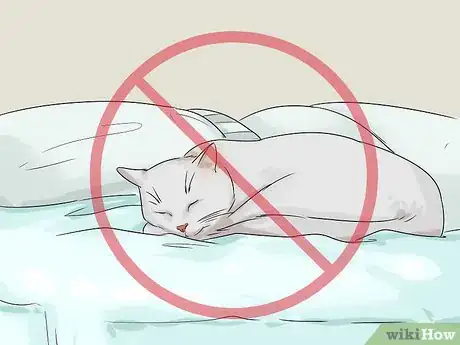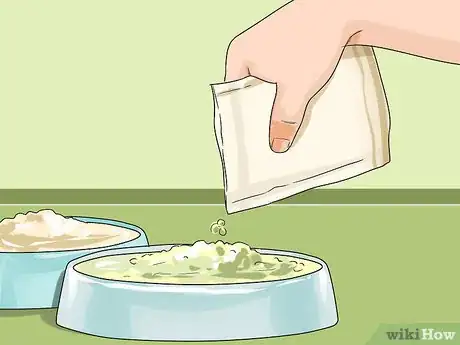This article was co-authored by Lauren Baker, DVM, PhD. Dr. Lauren Baker is a Veterinarian and Assistant Scientist at the University of Wisconsin-Madison. With over 10 years in veterinary medicine, she specializes in the concept of “one health,” which uses insights from veterinary medicine to help human medical research. She holds a Ph.D. in Comparative Biomedical Sciences, a Doctor of Veterinary Medicine, an MS in Comparative Biomedical Sciences, and a Bachelor’s degree in Psychology from the University of Wisconsin-Madison.
There are 10 references cited in this article, which can be found at the bottom of the page.
This article has been viewed 18,901 times.
Cats thrive on daily routines such as eating at particular times and napping in favorite spots. If you need to change your cat’s routine, you should take a gradual and cautious approach. Eating, sleeping and exercise routines are very important for your cat, as well as the coming and going of household members and the security of their eating and sleeping areas. With some patience and attention to your cat’s health, it is possible to change your cat’s eating, sleeping, exercise and other routines.
Steps
Adjusting to New Circumstances
-
1Change routines slowly. Instead of expecting your cat to adjust quickly to new circumstances, it is best to find ways of slowing down the changes in routine. For instance, if you want your cat to get used to a new cat food, you should gradually add a bit more of the new cat food into the old cat food every day. For any new routine, you should make slight, gradual adjustments instead of abrupt changes.[1]
- If you are starting a new mealtime, change their current mealtime by fifteen minutes every few days until you get to the new mealtime.
- If you want your cat to sleep at night, it is important to change their exercise routine during the day. Start playing with them for gradually longer periods during the day. Start with a new play period of ten minutes and gradually build it up until they are getting at least one hour of playtime during the day.
-
2Observe your cat’s behavior. See how your cat responds to changes in their routine such as a new playtime, new diet or new people in the house. If they seem anxious or stressed out, try to comfort them and determine why they are having trouble. Consider any changes in their routine or the household routine, as well as how you could make those changes easier on your cat.[2]Advertisement
-
3Avoid too many changes in routine. Cats love the security of a daily routine, so it is best to avoid changing their routine too frequently. It is also best not to change too many things at once.[3]
- If you have to move to a new city, for instance, avoid changing their diet at the same time.
- If you are trying to get them to sleep at night, avoid changing their diet at the same time as their sleep routine.
-
4Use a gradual approach with new cats. If you have a new cat in your home, keep them separate from your old cat for the first day or two. Swap bedding or toys between your cats so they can get to know one another through smell. Once they have smelled one another, you can introduce them directly. Let them sniff each other out in a common and neutral area of the house, such as a living room.
-
5Let your cat get accustomed to a new baby on their own time. Your cat may take some time to get used to the new baby. You can make the change easier by introducing your cat to the smell of the baby with some clothing or a baby blanket, prior to bringing the baby home from the hospital. You can also try pheromone scent products to calm your cat. Eventually, your cat will get used to the new family member.
-
6Transition your outdoor cat to the indoors. If you need to change your outdoor cat's routines to fit with a new indoor environment, you need to consider potty training as well as playtime. If your cat was potty trained but is used to going to the bathroom outdoors, you could place the kitty litter beside the door. When they want to go outside to go to the bathroom, they will use the kitty litter instead. You should also make a stimulating indoor environment, including interactive toys and perches where your cat can watch the backyard environment.[4]
- When you leave the house, make sure your cat is a good distance from the doorways since they will want to escape.
- If your cat was not potty trained, you will need to start from scratch.
-
7Recognize that shifts in routine can damage your cat’s health. Cats thrive on routine and typically do not respond very well when it changes, especially if the changes are abrupt. There is some evidence that too frequent changes in routine can negatively impact the health of cats.[5]
Switching Your Cat’s Nighttime Routine
-
1Schedule playtime during the day. Make some time at lunch or right after work to play with your cat. Throw a toy mouse for your cat or give your cat a ball of string to chase. Your cat will get tired out and will be more likely to sleep during the night.[6]
-
2Use interactive toys if you are away during the day. Cat towers with scratch surfaces and hanging balls to hit, mice and other toy animals for your cat to hunt and scratching pad toys are all good options. There are also circuit games where your cat gets to hunt a ball through a maze.[7]
- Interactive cat toys range in price from $6 to $60.
- Consider finding a toy that requires minimum work on your part, so that your cat can play alone during the day.
-
3Let your cat outdoors during the day. If you live in the country and it is safe, you can let your cat outdoors during the day. Your cat will be able to climb trees, hunt and explore. After all of the daytime activity, your cat will be more likely to sleep at night.[8]
- Allowing your cat outdoors always carries some risk. Other animals, parasites, and the elements all pose dangers to your cat. Consider this carefully before choosing to let your cat outdoors unsupervised.[9]
- If you decide to let your cat outdoors, be sure your cat is spayed or neutered and up to date on vaccinations, flea and tick control, and heartworm prevention.
-
4Install a bird feeder. Watching birds is a fun routine for cats, especially if you need to keep them indoors. If you live in an area that accommodates a bird feeder, consider installing it in a location where your cat will be able to see it. Your cat will enjoy the activity and it will keep them occupied while you are busy with other things.[10]
-
5Feed your cat after playtime. Offer a high protein meal to your cat after your post-work playtime session. The combination of exercise and food will prepare your cat for nighttime rest.[11]
- Look into high protein food. High protein diets are generally healthier for cats.[12]
- Try searching for high-protein options at your local pet store.
-
6Don’t let your cat sleep in your bedroom. It is important to set boundaries early in the life of your cat, so that they know not to disturb you during the night. If your cat is disturbing you at night, consider closing the door to prevent them from accessing your room and waking you.[13]
-
7Avoid responding to your cat during the night. If your cat starts scratching at your bedroom door, try to ignore it. You should avoid giving in and playing with your cat, which will set up a positive feedback cycle, encouraging your cat to wake you up at night. Try to simply ignore your cat or put them in a different part of the house where they can’t disturb you as easily.[14]
- You should also avoid negatively responding to your cat with anger or physical violence. In fact, any reaction to your cat may encourage them to continue the behavior. Simply ignore them when you can.
Changing Your Cat’s Eating Routine
-
1Make gradual changes to your cat’s diet. If you need to get your cat on a prescribed diet, you should gradually wean them onto the new food. Serve them a combination of the new and the old diet in their usual portion size. Decrease the amount of the old food in their serving by one tablespoon per day.[15] Eventually, you will be ready to shift them entirely onto the new food.[16]
- If you accustom your cat to a varied diet early in life, it will be easier to shift them onto a new or prescribed diet.
-
2Serve the new food in the old bowl. Place the new food in the bowl they know, alongside some of the old food in another familiar bowl alongside it. You can also mix the two together in one familiar bowl. If your cat does not touch the new food, put the bowl in the fridge and try again at the next mealtime. Continue trying until they start eating the new food.[17]
- Do not keep canned cat food in the fridge for more than five days.
-
3Add delicious toppings to the new diet. You could try adding a bit of canned salmon or other favorite foods to your cat's new diet. They will focus on the flavors from their favorite dishes and gradually become accustomed to the new food.[18]
-
4Create a peaceful and secure eating area. If you have recently moved or need to change the location of your cat’s eating area for another reason, you should find a peaceful location. The eating area should be a good distance away from the kitty litter, since cats do not like to eat close to where they do their business. It should also be in a secure location, away from noisy areas of the house.[19]
- If you own multiple cats, you should give each cat their own food bowl. If possible, feed them in different areas where they cannot see one another. This will reduce the stress of mealtime.
- Some cats like their water in a different location from their food.
-
5Avoid feeding your cat the same food all the time. You can make future dietary changes easier by varying your cat’s diet once in a while. Instead of always feeding them wet food, give them dry food once in a while. If you typically buy the same brand, try a different brand periodically. When the time comes for a prescribed dietary change, your cat will be more likely to accept it.[20]
References
- ↑ http://www.playfulkitty.net/2016/08/09/helping-your-cat-through-changes-in-routine/
- ↑ http://www.playfulkitty.net/2016/08/09/helping-your-cat-through-changes-in-routine/
- ↑ http://www.playfulkitty.net/2016/08/09/helping-your-cat-through-changes-in-routine/
- ↑ https://www.petfinder.com/cats/cat-care/transitioning-outdoor-cat/
- ↑ http://consciouscat.net/2015/01/07/cats-thrive-routine/
- ↑ http://www.cat-world.com.au/how-to-stop-the-night-time-crazies
- ↑ https://bluebuffalo.com/articles/cat/how-to-change-your-cats-nighttime-habits-so-you-can-sleep/?returnTo=/articles/home/
- ↑ https://bluebuffalo.com/articles/cat/how-to-change-your-cats-nighttime-habits-so-you-can-sleep/?returnTo=/articles/home/
- ↑ https://www.petfinder.com/cats/cat-care/6-indoor-outdoor-cat-myths/
- ↑ http://consciouscat.net/2015/01/07/cats-thrive-routine/
- ↑ http://www.cat-world.com.au/how-to-stop-the-night-time-crazies
- ↑ http://www.huffingtonpost.com/dr-karen-becker/healtthy-cat-diet_b_865604.html
- ↑ http://www.cat-world.com.au/how-to-stop-the-night-time-crazies
- ↑ https://bluebuffalo.com/articles/cat/how-to-change-your-cats-nighttime-habits-so-you-can-sleep/?returnTo=/articles/home/
- ↑ https://indoorpet.osu.edu/veterinarians/low-stress-diet-and-feeding-changes-cats
- ↑ http://www.catbehaviorassociates.com/why-your-cat-might-be-a-picky-eater/
- ↑ https://indoorpet.osu.edu/veterinarians/low-stress-diet-and-feeding-changes-cats
- ↑ https://indoorpet.osu.edu/veterinarians/low-stress-diet-and-feeding-changes-cats
- ↑ http://www.catbehaviorassociates.com/create-a-peaceful-mealtime-for-your-cat/
- ↑ http://www.catbehaviorassociates.com/why-your-cat-might-be-a-picky-eater/
About This Article
To change your cat's routine, it's best to start slow and gradually incorporate the adjustments, since cats crave stability and often react poorly to abrupt changes. For example, if you want to start your cat on a new cat food, gradually add a little of the new cat food to the old cat food every day. If you want to change your cat's meal time, adjust it by 15 minutes or so every few days. Try to stick to one change at a time rather than making lots of changes all at once for the best results! For more tips on making dietary changes, read on!




